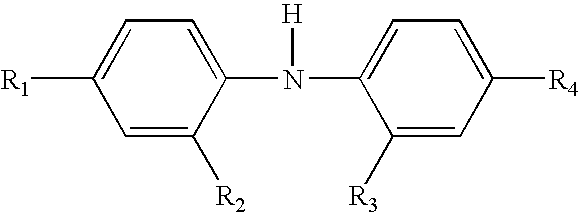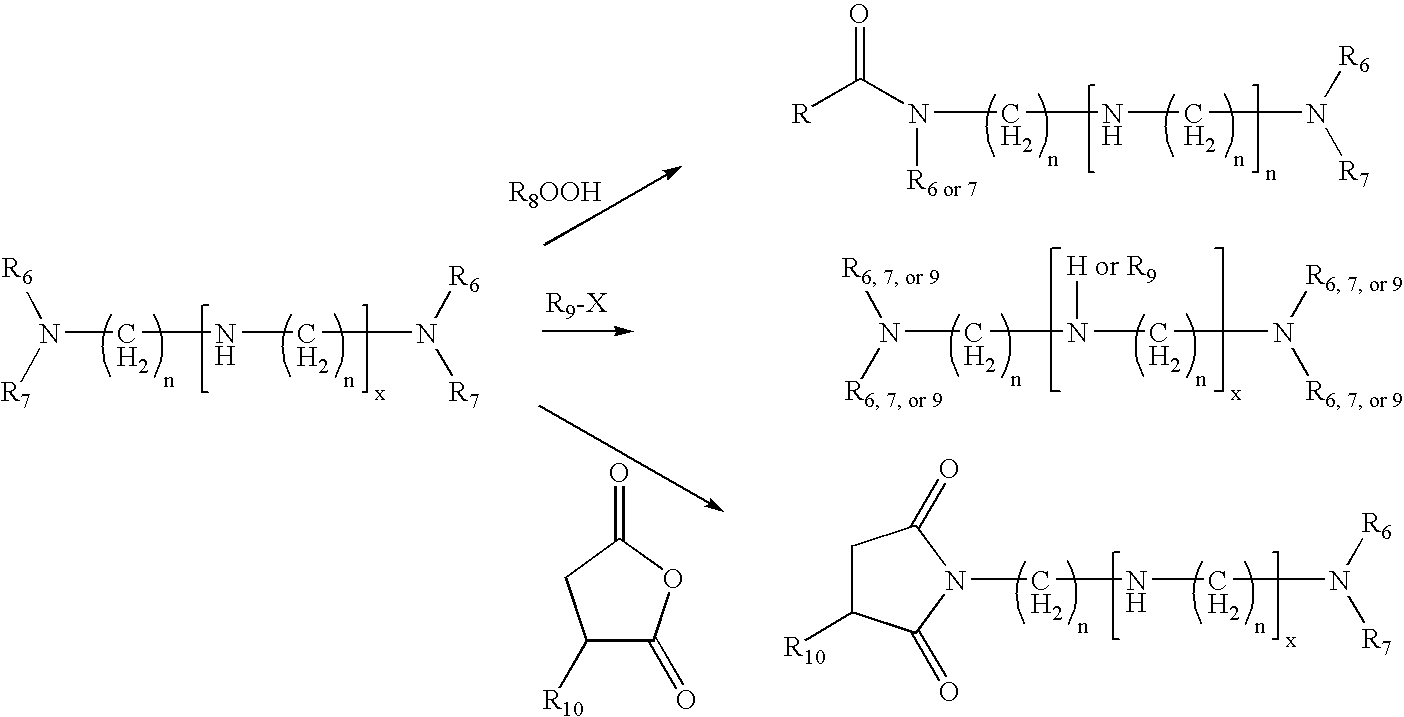Antioxidant Synergist for Lubricating Compositions
- Summary
- Abstract
- Description
- Claims
- Application Information
AI Technical Summary
Benefits of technology
Problems solved by technology
Method used
Image
Examples
example a
[0065] The following example, with data set forth in Table A, shows antioxidant synergism that exists between ADPA, C6-18 monoglyceride and ethoxylated amide mixture and mono succinimide dispersant derived from polyethyleneamines and polyisobutylene succinic anhydride dissolved in 35 to 50 mass percent solvent de-waxed heavy paraffinic petroleum distillates. The C6-18 monoglyceride and ethoxylated amide mixture prepared by reacting 1 mole coconut oil with approximately 2.0 moles of diethanol amine,
TABLE A12345C6-18 Monoglyceride / 10.50.5Ethoxylated Amide Mixture(3:7 mass percent ratio)Vanlube 961110.50.5Mono Succinimide Dispersant5555Durasyn 16629594949994PDSC OIT at 180° C.Minutes5.441.45.244.567
1Vanlube ® 961 is ADPA available from R. T. Vanderbilt Company, Inc.
2Durasyn ® 166 is synthetic poly-α-olefin base oil.
example b
[0066] The following example, with data set forth in Table B, shows antioxidant synergisms that exist between ADPA, mono succinimide dispersant, and monoglyceride, ethoxylated amide, or mixtures thereof in the presence of phosphorus in the form of ZDDP. Data shows that the glycerol carboxylate, ethoxylated amide and mixtures thereof are useful in recovering antioxidant capacity lost when phosphorus levels are reduced.
TABLE B67891011C6-18 Monoglyceride / 0.50.5Ethoxylated Amide Mixture(3:7 mass ratio)C6-18 Monoglyceride0.15C6-18 Di-ethoxylated Amide0.35Vanlube 9610.50.50.50.50.5Mono succinimide Dispersant555555Durasyn 16693.7949493.593.8593.65ZDDP0.90.50.50.50.50.5Phosphorus Content0.080.0470.0470.0470.0470.047PDSC OIT at 180° C.Minutes20316519.3227227.3203
example c
[0067] The following example, with data in Table C, shows antioxidant synergism that exists between ADPA, polyamine dispersant and borated monoglyceride / ethoxylated amide mixture in the presence of phosphorus (by way of ZDDP). Data shows that the glycerol carboxylate / ethoxylated amide mixture is useful in recovering antioxidant capacity lost when phosphorus levels are reduced, and also demonstrates that acceptable antioxidant capacity is achieved even where phosphorus is eliminated. In addition, the data serve to demonstrate the particular synergy of the 3-component system, compared to a system lacking the dispersant (compare test 18 v. test 17). Even without phosphorus, the 3-component system shows a PDSC OIT result at 81.1, which is above the acceptable minimum of about 55.
TABLE C12131415161718192021Vanlube 2898110.50.51.00.51.0Vanlube 9610.5110.50.50.50.50.5Mono Succinimide555555DispersantDurasyn 166999699.59994999693.693.593ZDDP0.50.5Phosphorus Content000000000.0470.047PDSC OI...
PUM
| Property | Measurement | Unit |
|---|---|---|
| Percent by mass | aaaaa | aaaaa |
| Percent by mass | aaaaa | aaaaa |
| Percent by mass | aaaaa | aaaaa |
Abstract
Description
Claims
Application Information
 Login to View More
Login to View More - R&D
- Intellectual Property
- Life Sciences
- Materials
- Tech Scout
- Unparalleled Data Quality
- Higher Quality Content
- 60% Fewer Hallucinations
Browse by: Latest US Patents, China's latest patents, Technical Efficacy Thesaurus, Application Domain, Technology Topic, Popular Technical Reports.
© 2025 PatSnap. All rights reserved.Legal|Privacy policy|Modern Slavery Act Transparency Statement|Sitemap|About US| Contact US: help@patsnap.com



